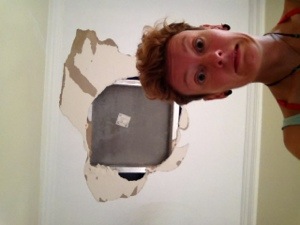I’m leaving Mumbai later today to go to Pune but let me tell you about what I’ve been getting up to.
Rich pickings
Walking along Colaba Causeway to eat at Leopold’s Cafe (for anyone who’s read Shantaram…) and a beggar lady in a beautiful sari starts saying to me, “Madam, I need rice for my children to eat”. She walks just a little in front of me. I try to shake her off by stopping but she sees me and soon catches on. It’s a narrow street and there’s lots of people. At one point I stop abruptly and a boy walks into the back of me. I hug my bag to my front. I stop again and he walks into me again and the lady catches his eye.
He’s trying to pickpocket me! They’re setting me up! The buggers! They fail.
“Madam, a slight problem in your room”
I come back to my vastly improved hotel and the guy on reception stops me saying the above. He opens my room door and explains that, while I was out, part of the ceiling collapsed directly over my bed. There’s a huge hole covered from above by a sheet of MDF. “We change the sheets and clean. Everything ok?” Hilarious.
Slumdog
I go on a tour of Dharavi, Mumbai and Asia’s largest slum. It’s where some of the Danny Boyle film was shot and it’s amazing.
Five of us and a guide spent the afternoon walking through tiny dark alleyways with kids squeezing past us, peering into workshops only to see a room full of guys in string vests smiling back at us, and standing on rooftops surrounded by mountains of plastic split by colour. The slum is home to one million people and covers only 174 hectares. It originally was swampland but people have been living there since the 1840’s.
What impressed me most was how organised it was. There are distinct areas for different industries including clay pottery, plastic recycling, metal can recycling, leather and handbag-making, and heavy industry with sparks flying. The residential area is separate with the divide marked by a rather smelly river. Unemployment and crime is low although diseases such as cholera and malaria keep the numerous health centres busy.
We watched bakers producing goods to be eaten as far away as Afganistan and men behind old singer sewing machines making leather jackets to be sold by the brand ‘Lee’. The recycled plastic is used in electronics by companies such as Samsung. The guide quoted these companies to demonstrate the quality of the work carried out in Dharavi. Their company profits must be astronomical.
We learnt that tax evasion is the biggest crime and that each toilet is used by over 1000 people. The average income is around £1.50 a day and, due to demand, it costs around £50 a month to rent a tiny room. There’s often four to six people per room. In this space they cook, eat, wash, sleep, watch TV and often have the internet. And I thought my studio flat was small.
The tour was carried out sensitively and you didn’t feel that you were intruding – or that you weren’t welcome. No photos were allowed and 80% of the tour cost goes towards local community projects. I’d highly recommend it. Visit www.realitytoursandtravel.com for more information.
And finally…
It’s Navratri here in India. That means nine days of festivities in streets covered by canopies of fairy lights. It celebrates the Hindu goddess Durga and ‘Navratri’ literally means ‘nine nights’ in Sanskrit. Each night, different forms of the divine mother or ‘Shakti’ or ‘Devi’ are worshipped. It’s a big deal in Mumbai.
People dance every night to live bands and I even heard Ganga Arati, taking me back to my Sivananda teacher training on the banks of the Ganges. We had to chant it twice a day. There’s a wonderful atmosphere.
See you in Pune, the land of Iyengar yoga and the sex guru Osho!


